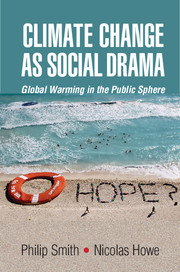Book contents
- Frontmatter
- Contents
- Acknowledgments
- 1 Introduction: The Problem of Climate Change
- 2 Climate Change as Social Drama
- 3 Narrating Global Warming
- 4 An Inconvenient Truth: The Power of Ethos
- 5 Climate Change Art: An Illustrative Failure?
- 6 Climategate and Other Controversies
- 7 The Climate Conference as Theatre
- 8 Local Dramas: The Places of Climate Change
- 9 Conclusion: The Show Must Go On
- References
- Index
6 - Climategate and Other Controversies
Published online by Cambridge University Press: 05 May 2015
- Frontmatter
- Contents
- Acknowledgments
- 1 Introduction: The Problem of Climate Change
- 2 Climate Change as Social Drama
- 3 Narrating Global Warming
- 4 An Inconvenient Truth: The Power of Ethos
- 5 Climate Change Art: An Illustrative Failure?
- 6 Climategate and Other Controversies
- 7 The Climate Conference as Theatre
- 8 Local Dramas: The Places of Climate Change
- 9 Conclusion: The Show Must Go On
- References
- Index
Summary
We have seen that films and artworks are a significant path along which climate change activists attempt to arrive at public visibility. These are deliberately articulated attempts to stoke the fires of the social drama and to inject passion into what activists fear is perceived as a dull issue. Yet perhaps the most important and direct route of transition from back-ground noise to the center of the social attention space is through the circuits of “news” production and consumption. A capacity to be news- worthy is of the utmost importance along many dimensions. Simply being selected out for news coverage marks climate change as a significant issue worthy of priority relative to the panoply of problems every society faces. Whether critical or benign, talk about climate change in a “news” forum gives an implicit ranking to this ecological problem, making it visible as a public issue. It is also significant to note that the news reaches a numerically large and socially dispersed audience. Films and artworks appeal to limited social constituencies. As we have seen, even within those constituencies, only a small proportion of people will find the time or energy (or in some cases have the basic social competence?) to thoughtfully engage with such creative products. By contrast, exposure to whatever is in the news is somewhat nonelective and is robotically embedded in daily routines – reading the paper on the train, listening to the radio on the drive to work, checking out CNN, the BBC, or Democracy Now! online during the lunch break, and so forth. In addition, the field of “news” tends to reach over social barriers. To a substantial extent, the same “important” or “newsworthy” events are carried in highbrow and lowbrow formats, on radio, television, print, and the Internet. A final plus to getting into the news is that coverage is cost free.
- Type
- Chapter
- Information
- Climate Change as Social DramaGlobal Warming in the Public Sphere, pp. 118 - 144Publisher: Cambridge University PressPrint publication year: 2015

